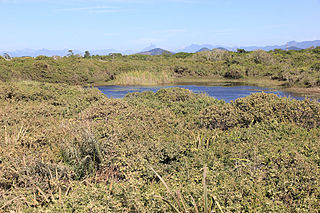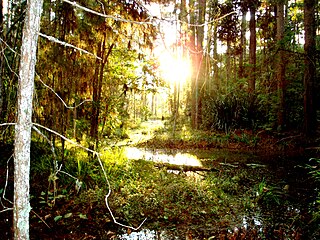 W
WAdolfo Ducke Forest Reserve. The reserve was established in 1963 in honour of the entomologist and botanist Adolfo Ducke who was one of the most respected experts on Amazonian flora and is a 10,000 ha protected area on the outskirts of Manaus. It is part of the Long Term Ecological Research (LTER) Network. The reserve sits at the intersection of two major drainage areas, the Amazon River and the Rio Negro. The reserve is made up of research plots designed to study the biota of the regions, which may serve as a basis for biodiversity surveys in other areas of the Amazon region, and to study the impacts of fragmentation. The grid of LTER sites is made up of. Within the grid, which is used for straight line transect surveys of biodiversity, there are 250 m long permanent survey plots.
 W
WThe Environmental Protection Area (APA) of Copacabana and Arpoador Promontories, in Rio de Janeiro, Brazil, was created to protect its rocky coast and native plant life species.
 W
WBosque Alemão is a park built in Curitiba in honor of the German immigrants who begin to settle in the city in the early 19th century.
 W
WCampos Gerais National Park is a national park in the state of Paraná, Brazil.
 W
WThe Catimbau National Park is a national park in the state of Pernambuco, Brazil. It protects a semi-arid area of caatinga with sandstone caverns and caves in which prehistoric art has been found.
 W
WThe Itiquira Falls is a waterfall in Brazil. They are located 34 kilometers north of Formosa in the state of Goiás and 115 kilometers from Brasília on a paved road. The falls have a height of 168 meters, making them possibly the highest accessible waterfall in Brazil and the second highest overall. The falls are formed by the drop of the Itiquira River from the higher central plateau north of Formosa into the deep Paranã River valley. The waters are unpolluted and a bottling plant is located on the river above the falls.
 W
WThe Botanical Garden of São Paulo is a botanical garden in São Paulo, Brazil. The park spans a 164.45 hectare area in the Fontes do Ipiranga State Park, at the district of Água Funda, in São Paulo's South zone, next to São Paulo Zoo. It houses the state's Botanical Institute. It was founded, in its current location, in 1928, by the botanist Frederico Carlos Hoehne.
 W
WThe Jurubatiba Sandbank National Park is a national park in the Brazilian state of Rio de Janeiro. The park has approximately 44 kilometres of sandbank coast.
 W
WJardim da Luz is a public park near the Luz station and Avenida Tiradentes in the Bom Retiro district of São Paulo. The headquarters of the Pinacoteca do Estado de São Paulo is located in the southeastern corner of the park.
 W
WThe Marapendi Natural Municipal Park is a municipal nature park, a public recreation facility of approximately 155 hectares within the Marapendi Natural Reserve, located in the Barra da Tijuca and Recreio neighborhoods of Rio de Janeiro, Brazil and part of a protected area for the preservation of native plants and animals.
 W
WParque da Cidade Dom Nivaldo Monte, colloquially known as Parque da Cidade, is a park in Natal, Rio Grande do Norte, Brazil. The City Park covers an area of 64 hectares, aimed at environmental preservation and education, and comprises eco-trails, jogging lanes, library, auditorium, orchidarium and more. The symbol of the Park is the central tower, 45 meter high, which houses the Memorial of the city, the Memorial should maintain exhibits about the history and development of Natal.
 W
WThe Palaeobotanical Garden is a natural reserve in the town of Mata, in the state of Rio Grande do Sul, Brazil.
 W
WPaleontological Site Jazigo Cinco is located in the city of Santa Maria, Rio Grande do Sul, Brazil. And belongs to Santa Maria Formation. It is located in the neighborhood Kilometro 3 near Castelinho, is to 2.7 kilometers away from the Paleontological Site Arroio Cancela. It belongs to UFSM and is a center of research. It is the place where he was collecting the Staurikosaurus, the first Brazilian dinosaur. Site belongs to the region paleorrota.
 W
WParque Enrique Lage is a public park in the city of Rio de Janeiro, located in the Jardim Botânico neighborhood at the foot of the Corcovado.
 W
WParque Trianon is a park located on Paulista Avenue in São Paulo, Brazil.
 W
WThe Pedra Pintada or "Painted Rock", is a large rock located in the state of Roraima, Brazil. It is 85 metres long, 35 metres high and 30 metres wide, and is found in the Boa Vista savanna. There are many pictograms and other archaeological evidence inscribed on the walls of the rock.
 W
WSanta Rita Biological Reserve is a biological reserve in the state of Minas Gerais, Brazil.
 W
WThe São Francisco de Paula National Forest is a national forest in the state of Rio Grande do Sul, Brazil.
 W
WSerra da Bocaina National Park is a national park of Brazil. It is located at the border between the states of Rio de Janeiro and São Paulo in southeastern Brazil.
 W
WThe Serra do Mar State Park is a state park in the state of São Paulo, Brazil. It covers 315,000 hectares of the Serra do Mar mountain range, and is one of the largest remaining areas of continuous Atlantic Forest. The State Park stretches from the border of Rio de Janeiro to Itariri in the southern part of São Paulo.
 W
WTamboré Biological Reserve is a municipal biological reserve in greater São Paulo, Brazil.
 W
WThe Terra Ronca State Park was created by decree nr. 10,879 of 7 July 1989 and had its area and boundaries established by decree nr. 4,700 of 21 August 1996, covering the municipality of São Domingos. Around the state park they created the environmental protection area (APA) of the Serra Geral, by decree nr. 4,666 of 16 April 1996. The areas of these two protected areas are of restricted use and regularly monitored and audited by the Agência Goiana de Meio Ambiente e Recursos Naturais, covering respectively 57,018 ha and 40,000 ha. It is one of the most beautiful and significant geo-morfologic sets of Brazil.
 W
WToca da Tira Peia is a rock shelter site, located in the municipality Coronel José Dias, Piauí state, near the Serra da Capivara National Park, Brazil, thought to hold evidence of prehistoric human presence in South America dating to 22,000 years ago.
 W
WThe National Forest of Três Barras is a Federal Conservation Unit of sustainable use, managed by the Chico Mendes Institute for Biodiversity Conservation - ICMBio, in the municipality of Três Barras, Santa Catarina, Brazil.
 W
WVila Fachini Biological Reserve is a biological reserve in the city of São Paulo, Brazil.
 W
WThe Zoo Botanical Park Dois Irmãos, is located in the city of Recife, state of Pernambuco - Brazil. The park has an area of 384.4 ha, 14 of which is dedicated for the Zoo Botanical and a Natural Science Museum, and the remaining area for an Atlantic Forest reserve. This park offers to the visitors the possibility to know about the local ecosystems, plants and wildlife. It has about 650 animals - birds, reptiles and mammals - from more than 120 species. It is the most representative Zoo in the North/Northeast region of Brazil, highlighted by events and pioneers innovative activities in areas such environmental education and breeding animals in captivity. Also in this park, nature knowledge is acquired through experience and direct contact with animals, making the Zoo no longer just a window of animals to become a Nature conservation center. The park was founded in 1916, in the land of engenho Dois Irmãos, owned by Antonio and Tomas Lins Caldas.